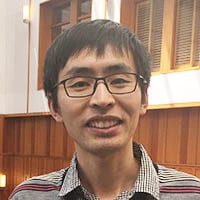Research Summary
My previous work focused mainly on early embryo development and stem cells. Gastrulation is the most important process of early embryo development. However, the gene expression profile of this process had not been well illustrated, because of its extremely small size. I developed Geographical position sequencing (Geo-seq), which combines laser microdissection and single cell sequencing, allowing us to simultaneously elucidate cell heterogeneity and spatial variance of only a small number of cells. With the help of Geo-seq, we constructed 3D transcriptome atlas of mid-gastrulating mouse embryo. Moreover, I studied dynamics and roles of high-order chromatin architecture in stem cells.
Neural stem cells (NSCs) give rise to newborn neurons in a process called neurogenesis, supporting cognitive functions in the brain throughout life. mRNA modifications have great importance for the stabilization, translation, and localization of mRNA. However, the functions of mRNA modifications in neural stem cells are still poorly understood. Therefore, I’m trying to investigate the functions and mechanisms of mRNA modifications for the self-renewal and differentiation of neural stem cells.
Impact in China
The population in China is getting older faster than anywhere else in the world. An ever-increasing number of aged Chinese are afflicted with a spectrum of neurodegenerative diseases such as Alzheimer’s disease, Parkinson’s disease, and Huntington’s disease. The most common symptom of these disorders is the progressive loss of neural cells, which leads to dysfunction of nervous system. Neural stem cells are of crucial importance for maintaining tissue homeostasis and for neuronal repair after injury or in neurodegenerative diseases. I hope that what I’m learning today at UC Berkeley will benefit more Chinese in the near future.
Publications
- Jun Chen*, Shengbao Suo*, Patrick Pl Tam, Jingdong Jacky Han#, Guangdun Peng#, Naihe Jing#. Spatial transcriptomic analysis of cryosectioned tissue samples with Geo-seq. Nature Protocols, (2017) 12(3), 12(3), 566~580 (*, Co-first author)
- Guangdun Peng*, Shengbao Suo*, Jun Chen*, Weiyang Chen, Chang Liu, Fang Yu, Ran Wang, Shirui Chen, Na Sun, Patrick P.L. Tam, Jing-Dong Jackie Han#, Naihe Jing#. Spatial transcriptome for the molecular annotation of lineage fate and cell identity in mid-gastrua mouse embryo. Developmental Cell (2016) 36(6),681-689. (*, Co-first author)
- Chang Liu, Ran Wang, Zhisong He, PierreOsteil, Emilie Wilkie, XianfaYang, Jun Chen, Guizhong Cui, Wenke Guo, Yingying Chen, Guangdun Peng, Patrick P.L.Tam, Naihe Jing. Suppressing Nodal Signaling Activity Predisposes Ectodermal Differentiation of Epiblast Stem Cells. Stem Cell Reports (2018) 11(1), 43-57
- Xianfa Yang*, Boqiang Hu*, Yu Hou*, Yunbo Qiao#*, Ran Wang, Yingying Chen, Yun Qian, Su Feng, Jun Chen, Chang Liu, Guangdun Peng, Fuchou Tang#, Naihe Jing#. Silencing of developmental genes by H3K27me3 and DNA methylation reflects the discrepant plasticity of embryonic and extraembryonic lineages. Cell Research. (2018), doi:10.1038/s41422-018-0010-1
- Su Feng*, Can Xing*, Tingyu Shen, Yunbo Qiao, Ran Wang, Jun Chen, Jiaoyang Liao, Zhuo Lu, Xiong Yang, Saber Abd-Allah, Jinsong Li, Naihe Jing, and Ke Tang. Abnormal Paraventricular Nucleus of Hypothalamus and Growth Retardation Associated with Loss of Nuclear Receptor Gene COUP-TFII. Scientific Reports. (2017) dio:10.1038/s41598-017-05682-6
- Xiongjun Wang*, Yunbo Qiao*, Minzhe M Xiao*, Lingbo Wang, Jun Chen, Wenjian Lv, Li Xu, Yan Li, Yumei Wang, Ming-Dian Tan, Chao Huang, Jinsong Li, Ting C Zhao, Zhaoyuan Hou#, Naihe Jing#, Y Eugene Chin#,Opposing Roles of Acetylation and Phosphorylation in LIFR-Dependent Self-Renewal Growth Signaling in Mouse Embryonic Stem Cells.,Cell Reports, (2017) 18(4), 933~946
- Lu Song, Jun Chen, Guangdun Peng, Ke Tang, Naihe Jing. Dynamic Heterogeneity of Brachyury in Mouse Epiblast Stem Cells Mediates Distinct Response to Extrinsic Bone Morphogenetic Protein (BMP) Signaling. The Journal of Biological Chemistry (2016) 291(29), 15212~15225
- Lingyu Li, Lu Song, Chang Liu, Jun Chen, Guangdun Peng, Ran Wang, Pingyu Liu, Ke Tang, Janet Rossant, Naihe Jing. Ectodermal progenitors derived from epiblast stem cells by inhibition of Nodal signaling. Journal of Molecular Cell Biology (2015) 7 (5): 455~465
- Pingyu Liu, Xiaoyang Dou, Chang Liu, Lingbo Wang, Can Xing, Guangdun Peng, Jun Chen, Fang Yu, Yunbo Qiao, Lu Song, Yuxuan Wu, Chunmei Yue, Jinsong Li, Jing-Dong Han, Ke Tang, and Naihe Jing. Histone deacetylation promotes mouse neural induction by restricting Nodal-dependent mesendoderm fate Nature Communications. (2015) doi:10.1038/ncomms7830.
- Lu Song*, Na Sun*, Guangdun Peng, Jun Chen, Jing-Dong Jackie Han, Naihe Jing. Genome-wide ChIP-seq and RNA-seq analyses of Pou3f1 during mouse pluripotent stem cell neural fate commitment. Genome Data, (2015), 5:375~377
- Qingqing Zhu*, Lu Song*, Guangdun Peng, Na Sun, Jun Chen, Ting Zhang, Nengyin Sheng, Wei Tang, Cheng Qian, Yunbo Qiao, Ke Tang, Jing-Dong J Han, Jinsong Li, Naihe Jing. The transcription factor Pou3f1 promotes neural fate commitment via activation of neural lineage genes and inhibition of external signaling pathways. eLife (2014)10.7554/eLife.02224.
- Yunbo Qiao, Yue Zhu, Nengyin Sheng, Jun Chen, Ran Tao, Qingqing Zhu, Ting Zhang, Cheng Qian, Naihe Jing. AP2γ regulates neural and epidermal development downstream of the BMP pathway at early stages of ectodermal patterning. Cell Research (2012) 22(11), 1546~1561.
- Chengyang Huang, Jun Chen, Ting Zhang, Qingqing Zhu, Yang Xiang, Charlie Degui Chen, Naihe Jing. The dual histone demethylase KDM7A promotes neural induction in early chick embryos. Developmental Dynamics (2010) 239, 3350~3357.
